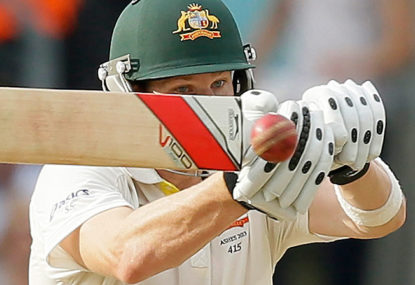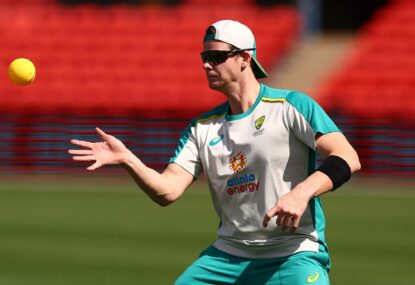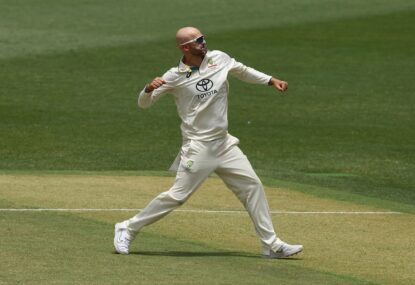Had Michael Clarke elected to keep batting on the third morning of this first Test against India on Thursday, Steve Smith could have had a Test double century within the hour.
Had I predicted that a couple of years ago, cricket fans would have suggested I take some time off to recuperate. Such is Smith’s rise that now, I was breezily confident of him mowing down the required runs with his bowlers for company.
>>FOLLOW THE LIVE SCORES OF THE AUSTRALIA VS INDIA TEST MATCH
It didn’t happen: he remained instead on 162 not out, while his bowlers prepared to hurl leather at Shikhar Dhawan.
But the fact that Smith now inspires confidence says a lot about the state of this team. For the first time in years, there is a sense of stability about the Australian batting order.
Since Clarke assumed the captaincy in 2011, Australia’s batting depended excessively on him. Ricky Ponting declined, Mike Hussey retired, Shane Watson healed and returned and broke again. The rest rode a carousel through the national team: Marcus North, Phillip Hughes, Usman Khawaja, Ed Cowan, Shaun Marsh, Rob Quiney, Moises Henriques, Glenn Maxwell, Smith himself in an earlier iteration.
Clarke carried the team when he could, and when he couldn’t, it fell. Others chipped in but never consistently. As a follower of Australian cricket, you were never confident the batsmen selected were the best picks for their spot. There were always a handful of other options. Anyone not picked was worth a punt. Everyone picked was a punt. Each Test was a matter of holding your nose and jumping, hoping for the best.
Clarke’s injury battles aside, he’s still a lock in Australia’s middle order. The difference is that now he has two other locks along with him, players with the proven ability to score heavily and regularly. Since David Warner returned to the team in the mid-2013 Ashes, he’s scored seven centuries and six fifties. Smith returned in the same series, and has scored five of each.
Around them, the value of Chris Rogers was finally realised, providing a steady hand opposite Warner, while Watson remains the preferred first drop when fit. That means Australia need a back-up at No. 3, and it’s early days for Mitchell Marsh at No. 6. But by now, Australia are closer than ever to finishing the puzzle.
Smith may prove the most important missing piece. Warner always had the talent: he made a brilliant century in only his second Test, and just had to work out his balance between defence and attack. Now that he has, he’s as unstoppable as we dreamed he might be. Smith is the bolter who has come from deep midwicket.
His first Test incarnation, in 2010, was as slogging No. 6 leg-spinner in a home Ashes flogging. His second was as a specialist spinner in England against a Pakistan side rotten with cheats. He lasted as long as they did. His third coming was almost accidental: included on the 2013 tour to India as a reserve batsman, something most of us laughed at, purely because he was seen to be a good player of spin. He wasn’t seen to be a guy who would play.
But then, four players were suspended over Mickey Arthur’s homework. Arthur’s mishandling of the incident brought about his demise, but it also left Smith as its wonderful inadvertent legacy.
In a series where India’s spinners would take 65 of the 79 wickets to fall, played on pitches so dry they were cracking into plates, where Australia’s last three innings had mustered 241, 237 and 131, Smith wandered to the middle with all calm and got within eight runs of a century. More important was the way that he played. Where Australia’s batsmen had been scared immobile, he advanced again and again to drive the spinners away or to defend. His footwork was nimble, impudent, accurate. It wasn’t about aggression but technique.
At Trent Bridge, Australia were 3 for 22 in a terrible reply to England’s 215. The game will be remembered for the last-ditch stand between Ashton Agar and Hughes, but that momentum first got going as Smith drove his way to 53, again twinkly-toed and carefree.
At Old Trafford, he racked up 89 in support of Clarke’s 187. At The Oval, he broke through for his first century, 138 not out, batting aggressively through to the declaration with last man Nathan Lyon.
In Perth, Australia were 5 for 143 before Smith turned saviour with 111, allowing them to claim the Ashes in straight sets. On a WACA deck bouncing at 90-degree angles, Smith hooked and pulled all day, swivelling on his heels, sending the ball time and again along the grass to deep midwicket.
Sydney was the same deal minus the bounce: 5 for 97, until Smith’s 115 turned it on its head. Centurion was 4 for 97 until Smith and Shaun Marsh tonned up. Newlands was about Warner’s twin centuries, but Smith’s 84 and 36* helped set up the win, all those runs against the bowling might of Dale Steyn and Co. on home pitches.
Then to the United Arab Emirates: when his teammates aside from Warner could barely pass 50, Smith produced 55 and 97 against Pakistan’s spinners, again comfortable with the different style of bowling and the hot and dry conditions.
Coming home to his new high score here in Adelaide, Smith has collected a full deck of cards, showing a mastery of conditions that defies his level of experience. Desert, grass, spin, seam, swing, home, away, packed to the rafters, quiet as the tomb: he’s been unruffled in facing that range. And while Adelaide might have provided some of the easier physical conditions, don’t underestimate the potency of this match’s emotional strain.
Smith has made it official: for the first time since Hussey’s retirement, there’s someone down the order that can be relied upon, a line of defence beyond Clarke. Alongside Warner, you have a couple of players in the right patch of their 20s: development behind them, the future ahead.
Talk of captaincy is premature, but right now what matters is that Australia have a genuine Test No. 5, and after the last few years that feels pretty good.
This article was first published on Wisden India.






































































































